Julia 中的数组是元素的集合,就像其他集合(如 Sets、Dictionaries 等)一样。 Arrays 与 Sets 不同,因为数组是元素的有序集合,并且可以保存重复值,不像集合要求所有元素都是唯一的。数组是 N 维容器,分为行和列。数组是可变数据类型,这意味着它们的内容可以被修改、删除、覆盖等。
数组是容器的异构类型,因此它们可以保存任何数据类型的元素。在将元素分配给数组之前定义数组的数据类型不是强制性的。 Julia 通过分析分配给数组的值自动决定数组的数据类型。由于数组的有序性质,可以更轻松地根据其索引对其值执行操作。

数组类型
根据它们的维度,数组可以是三种类型:
- 一维数组
- 二维数组
- 3D阵列
一维数组:
一维数组或一维数组是元素的线性表示。一维数组只能有一行或一列。它代表一种可由后续内存位置访问的列表类型。 Julia 中的一维数组称为向量。与其他类型的数组不同,向量允许从前面或后面添加元素,从而调整数组的大小。
例子:
A = [1, 2, 3, 4]
4-element Array{Int64, 1}:
1
2
3
4二维数组:
二维数组或二维数组是以行和列的形式表示项目。与向量不同,二维数组是数据的表格表示。 Julia 中的二维数组称为矩阵。使用行索引和列索引访问 Matrix 中的元素。可以通过在创建数组时从 Vector 中删除元素之间的逗号来创建 2D 数组。
A = [1 2; 3 4]
2×2 Array{Int64, 2}:
1 2
3 43D阵列:
3D 数组或 3 维数组是数组的数组。 3D 数组也称为多维数组。 3D 数组的类型为 NxNxN,其中组合数组可以是任何维度。可以使用cat或reshape命令创建 3D 阵列。
例子:
A = cat([1 2; 3 4], [5 6; 7 8], dims=3)
2×2×2 Array{Int64, 3}:
[:, :, 1] =
1 2
3 4
[:, :, 2] =
5 6
7 8在这里,您可以为“ dims ”指定任何值,然后将创建该维度的数组。
可以使用预定义的关键字Array()或简单地将数组元素写入方括号 ([]) 中来创建 Julia 中的数组。有不同的方法可以创建不同类型的数组。
- 可以通过简单地将数组元素写入方括号内以逗号(,) 或分号(;) 分隔来创建一维数组。
- 可以通过编写一组不带逗号的元素,然后用分号将该组与另一组值分开来创建 2D 数组。
- 类似地,可以使用“cat”命令创建 3D 阵列。此命令将数组和所需的维数作为输入,然后连接给定维数中的数组。
句法:
Array1 = [Value1, Value2, Value3, ...]
or
Array1 = [Value1 Value2 ; Value3 Value4]
or
Array1 = cat([Value Value; Value Value], [Value Value; Value Value], dims=3)Python3
# Julia program to illustrate
# the use of Arrays
# Creating a 1D array
Array1 = [1, 2, 3, 4]
println(Array1)
# Creating a 2D array
Array2 = [1 2 3; 4 5 6]
println(Array2)
# Creating a 3D array
# using 'cat' command
Array3 = cat([1 2; 3 4], [5 6; 7 8], [2 2; 3 4], dims = 3)
println(Array3)Python3
# Julia program to illustrate
# the use of Arrays
# Creating a 1D Array
Array1 = [1, 2, 3, 4, "Hello", "Geeks"]
# Passing index value
println(Array1[3])
# Accessing last value
println(Array1[end])
# Passing a bunch of index values
println(Array1[[3, 5, 6]])
# Passing a range of indices
println(Array1[3:end])
# Using true-false to print values
println(Array1[[true, true, false, false, false, true]])Python3
# Julia program to illustrate
# the use of Arrays
# Creating a 2D Array
Array1 = [1 2 "Hello"; 3 4 "Geeks"]
# Passing index value
# row-column wise
println(Array1[1, 3])
# Accessing last value
println(Array1[2, end])
# Using getindex() function
println(getindex(Array1, 2, 3))
# Using colon to indicate every row
println(Array1[:, 3])
# Using colon to indicate every column
println(Array1[1, :])Python3
# Julia program to illustrate
# the use of Arrays
# Creating a 3D array
# using 'cat' command
Array3 = cat([1 2; 3 4],
["hello" "Geeks"; "Welcome" "GFG"],
[5 6; 7 8], dims = 3)
# Accessing element using index value
println(Array3[1, 2, 2])
# Accessing Range of elements
println(Array3[1:2, 1:2, 2])
# Using colon to access every row or column
println(Array3[:, :, 3])
# Using getindex function
println(getindex(Array3, 1, 2, 2))
# Using getindex with colon operator
println(getindex(Array3, 1, :, 2))Python3
# Julia program to illustrate
# the use of Arrays
# Creating a 1D Array
Array1 = [1, 2, 3, 4, "Hello", "Geeks"]
# Adding element at the end
push !(Array1, "Welcome")
println(Array1)
# Adding element at the beginning
pushfirst !(Array1, 0)
println(Array1)
# Adding element at specific position
splice !(Array1, 3:4, "GFG")
println(Array1)
# Adding a range of elements
splice !(Array1, 6:7, [1, 2, 3])
println(Array1)Python3
# Julia program to illustrate
# the use of Arrays
# Creating a 2D Array
Array1 = [1 2 "Hello"; 3 4 "Geeks"]
# Array of elements which are to be added
Array2 = [5 6 7; 8 9 10]
# Appending arrays
Array3 = [Array1; Array2]
println(Array3)Python3
# Julia program to illustrate
# the use of Arrays
# Creating a 2D Array
Array1 = cat([1 2; 3 4],
["hello" "Geeks"; "Welcome" "GFG"],
dims = 3)
# Array of elements which is to be added
Array2 = cat([0 2; 1 4],
["GFG" "Geeks"; "abc" "def" ],
dims = 3)
# Appending arrays
Array3 = [Array1; Array2]
println(Array3)Python3
# Julia program to illustrate
# the use of Arrays
# Creating a 1D array
Array1 = [1, 2, 3, 4, 5, 6, "a", "b"]
println("Existing 1D Array:\n", Array1)
# Updating value at specific index
Array1[4] = "Hello"
println("\nUpdated 1D Array:\n", Array1)
# Creating a 2D array
Array2 = [1 2 3; 4 5 6]
println("\nExisting 2D Array:\n", Array2)
# Updating value at specific index
Array2[2, 2] = 10
println("\nUpdated 2D Array:\n", Array2)
# Creating a 3D array
Array3 = cat([1 2; 3 4],
["hello" "Geeks"; "Welcome" "GFG"],
dims = 3)
println("\nExisting 3D Array:\n", Array3)
# Updating value at specific index
Array3[2, 2, 2] = "World"
println("\nUpdated 3D Array:\n", Array3)Python3
# Julia program to illustrate
# the use of Arrays
# Creating a 1D array
Array1 = [1, 2, 3, 4, 5, 6, "Hello", "Geeks"]
println("Initial Array:\n", Array1)
# Delete last element
# using pop !()
pop !(Array1)
# Printing the array
println("\nArray after deleting last element:\n", Array1)
# Delete first element
# using popfirst !()
popfirst !(Array1)
println("\nArray after deleting first element:\n", Array1)
# Deleting a specific element
# using splice !()
splice !(Array1, 4)
println("\nArray after deleting a specific(e.g. 4th) element:\n", Array1)
# Deleting a range of elements
# using deleteat !()
deleteat !(Array1, 2:4)
println("\nArray after deleting a range(e.g. 2:4) of elements:\n", Array1)
# Deleting all the elements
# using empty !()
empty !(Array1)
println("\nArray after deleting all the elements:\n", Array1)Python3
# Julia program to illustrate
# the use of arrays
Array2 = [1 2 3; 4 5 6; "Hello" "Geeks" "World"]
println("Initial Array:\n", Array2)
# Assigning zero in place of
# element to be deleted(e.g. element at 1, 3)
Array2[1, 3] = 0
println("\nZero in place of element to be deleted:\n", Array2)
# Assigning undefined value in place of
# element to be deleted(e.g. element at 2, 3)
Array2[2, 3] = undef
println("\nundef in place of element to be deleted:\n", Array2)
# Deleting entire row of elements(e.g. 2nd row)
Array2 = Array2[1:size(Array2, 1) .!= 2, :]
println("\nArray after deleting 2nd row:\n", Array2)
# Deleting entire column of elements(e.g. 2nd column)
Array2 = Array2[:, 1:size(Array2, 2) .!= 2]
println("\nArray after deleting 2nd column:\n", Array2)Python3
# Julia program to illustrate
# the use of arrays
# Creating a 3D array
Array3 = cat([1 2 3; 3 4 5; 5 6 7],
["a" "b" "c"; "c" "d" "e"; "e" "f" "g"],
dims = 3)
println("Initial 3D Array:\n", Array3)
# Assigning zero in place of
# element to be deleted(e.g. element at 1, 3, 1)
Array3[1, 3, 1] = 0
println("\nZero in place of element to be deleted:\n", Array3)
# Assigning undefined value in place of
# element to be deleted(e.g. element at 1, 3, 2)
Array3[1, 3, 2] = undef
println("\nundef in place of element to be deleted:\n", Array3)
# Deleting entire row of elements(e.g. 2nd row)
Array3 = Array3[1:size(Array3, 2) .!= 2, :, :]
println("\nArray after deleting 2nd row:\n", Array2)
# Deleting entire column of elements(e.g. 2nd column)
Array3 = Array3[:, 1:size(Array3, 2) .!= 2, :]
println("\nArray after deleting 2nd column:\n", Array2)输出:
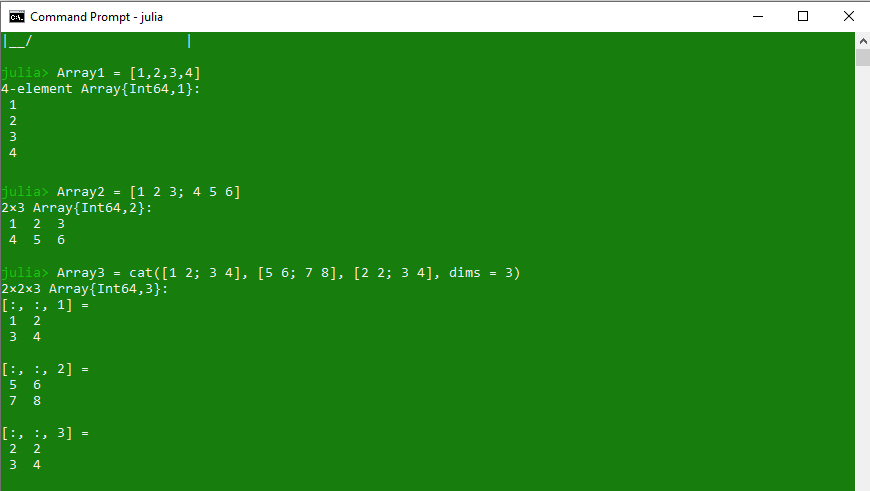
使用方括号 ([]) 可以轻松提取数组的元素。循环也可用于从数组中提取多个元素。此外,也可以通过在方括号内传递一个范围,就像元组一样,从数组中提取一系列元素。
示例:访问一维数组中的元素
蟒蛇3
# Julia program to illustrate
# the use of Arrays
# Creating a 1D Array
Array1 = [1, 2, 3, 4, "Hello", "Geeks"]
# Passing index value
println(Array1[3])
# Accessing last value
println(Array1[end])
# Passing a bunch of index values
println(Array1[[3, 5, 6]])
# Passing a range of indices
println(Array1[3:end])
# Using true-false to print values
println(Array1[[true, true, false, false, false, true]])

示例:访问二维数组中的元素
蟒蛇3
# Julia program to illustrate
# the use of Arrays
# Creating a 2D Array
Array1 = [1 2 "Hello"; 3 4 "Geeks"]
# Passing index value
# row-column wise
println(Array1[1, 3])
# Accessing last value
println(Array1[2, end])
# Using getindex() function
println(getindex(Array1, 2, 3))
# Using colon to indicate every row
println(Array1[:, 3])
# Using colon to indicate every column
println(Array1[1, :])

示例:访问 3D 数组中的元素
蟒蛇3
# Julia program to illustrate
# the use of Arrays
# Creating a 3D array
# using 'cat' command
Array3 = cat([1 2; 3 4],
["hello" "Geeks"; "Welcome" "GFG"],
[5 6; 7 8], dims = 3)
# Accessing element using index value
println(Array3[1, 2, 2])
# Accessing Range of elements
println(Array3[1:2, 1:2, 2])
# Using colon to access every row or column
println(Array3[:, :, 3])
# Using getindex function
println(getindex(Array3, 1, 2, 2))
# Using getindex with colon operator
println(getindex(Array3, 1, :, 2))
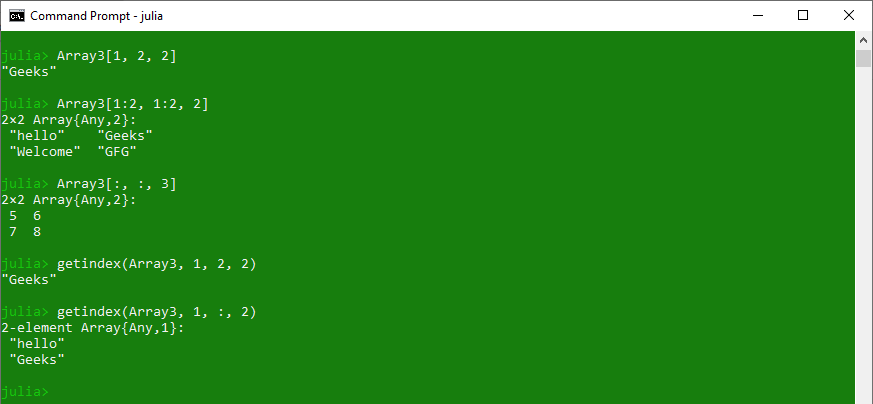
数组是 Julia 中的可变类型集合,因此,可以使用某些预定义的关键字来修改它们的值。 Julia 允许使用push在数组中添加新元素!命令。通过在拼接中传递索引值的范围,也可以在特定索引处添加数组中的元素!函数。
示例:在一维数组中添加元素
蟒蛇3
# Julia program to illustrate
# the use of Arrays
# Creating a 1D Array
Array1 = [1, 2, 3, 4, "Hello", "Geeks"]
# Adding element at the end
push !(Array1, "Welcome")
println(Array1)
# Adding element at the beginning
pushfirst !(Array1, 0)
println(Array1)
# Adding element at specific position
splice !(Array1, 3:4, "GFG")
println(Array1)
# Adding a range of elements
splice !(Array1, 6:7, [1, 2, 3])
println(Array1)

示例:在二维数组中添加元素
蟒蛇3
# Julia program to illustrate
# the use of Arrays
# Creating a 2D Array
Array1 = [1 2 "Hello"; 3 4 "Geeks"]
# Array of elements which are to be added
Array2 = [5 6 7; 8 9 10]
# Appending arrays
Array3 = [Array1; Array2]
println(Array3)
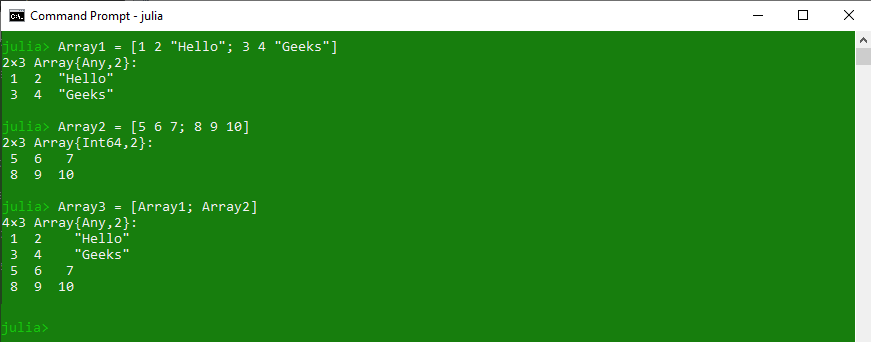
示例:在 3D 数组中添加元素
蟒蛇3
# Julia program to illustrate
# the use of Arrays
# Creating a 2D Array
Array1 = cat([1 2; 3 4],
["hello" "Geeks"; "Welcome" "GFG"],
dims = 3)
# Array of elements which is to be added
Array2 = cat([0 2; 1 4],
["GFG" "Geeks"; "abc" "def" ],
dims = 3)
# Appending arrays
Array3 = [Array1; Array2]
println(Array3)
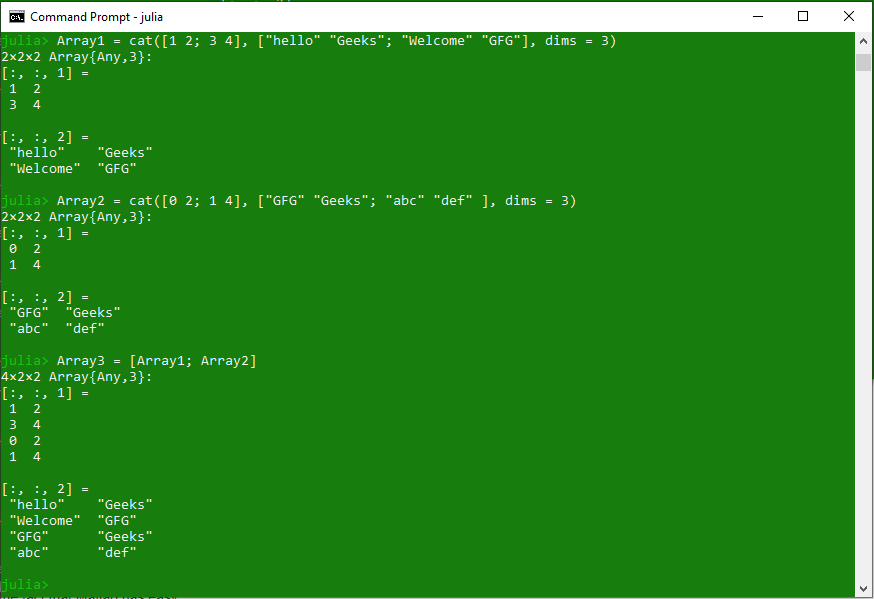
Julia 中的数组是可变的,因此它允许修改其内容。可以根据需要删除或更新数组中的元素。要更新数组的现有元素,请在方括号内传递该元素的索引值。
例子:
蟒蛇3
# Julia program to illustrate
# the use of Arrays
# Creating a 1D array
Array1 = [1, 2, 3, 4, 5, 6, "a", "b"]
println("Existing 1D Array:\n", Array1)
# Updating value at specific index
Array1[4] = "Hello"
println("\nUpdated 1D Array:\n", Array1)
# Creating a 2D array
Array2 = [1 2 3; 4 5 6]
println("\nExisting 2D Array:\n", Array2)
# Updating value at specific index
Array2[2, 2] = 10
println("\nUpdated 2D Array:\n", Array2)
# Creating a 3D array
Array3 = cat([1 2; 3 4],
["hello" "Geeks"; "Welcome" "GFG"],
dims = 3)
println("\nExisting 3D Array:\n", Array3)
# Updating value at specific index
Array3[2, 2, 2] = "World"
println("\nUpdated 3D Array:\n", Array3)


Julia 允许使用预定义的函数pop!从一维数组中删除元素。 .此函数将简单地删除数组的最后一个元素并将数组大小减少 1。要删除数组的第一个元素,可以使用popfirst!函数。如果需要从数组中的特定索引中删除元素,请拼接!并删除!可以使用函数。
这些方法仅适用于一维数组,因为二维或其他多维数组不允许从矩阵中删除特定元素以保持其(行、列)顺序。但是,可以在要删除的元素的位置指定零或 undef。这不会影响矩阵的顺序。另一种方法是删除整行或整列。
示例:从一维数组中删除元素
蟒蛇3
# Julia program to illustrate
# the use of Arrays
# Creating a 1D array
Array1 = [1, 2, 3, 4, 5, 6, "Hello", "Geeks"]
println("Initial Array:\n", Array1)
# Delete last element
# using pop !()
pop !(Array1)
# Printing the array
println("\nArray after deleting last element:\n", Array1)
# Delete first element
# using popfirst !()
popfirst !(Array1)
println("\nArray after deleting first element:\n", Array1)
# Deleting a specific element
# using splice !()
splice !(Array1, 4)
println("\nArray after deleting a specific(e.g. 4th) element:\n", Array1)
# Deleting a range of elements
# using deleteat !()
deleteat !(Array1, 2:4)
println("\nArray after deleting a range(e.g. 2:4) of elements:\n", Array1)
# Deleting all the elements
# using empty !()
empty !(Array1)
println("\nArray after deleting all the elements:\n", Array1)
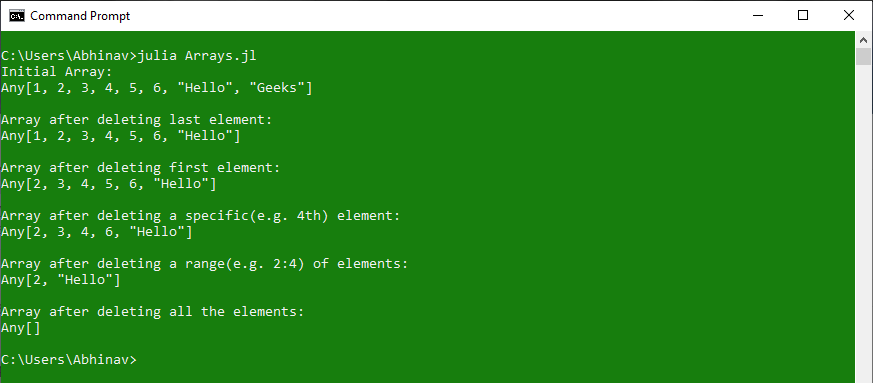
示例:从二维数组中删除元素
蟒蛇3
# Julia program to illustrate
# the use of arrays
Array2 = [1 2 3; 4 5 6; "Hello" "Geeks" "World"]
println("Initial Array:\n", Array2)
# Assigning zero in place of
# element to be deleted(e.g. element at 1, 3)
Array2[1, 3] = 0
println("\nZero in place of element to be deleted:\n", Array2)
# Assigning undefined value in place of
# element to be deleted(e.g. element at 2, 3)
Array2[2, 3] = undef
println("\nundef in place of element to be deleted:\n", Array2)
# Deleting entire row of elements(e.g. 2nd row)
Array2 = Array2[1:size(Array2, 1) .!= 2, :]
println("\nArray after deleting 2nd row:\n", Array2)
# Deleting entire column of elements(e.g. 2nd column)
Array2 = Array2[:, 1:size(Array2, 2) .!= 2]
println("\nArray after deleting 2nd column:\n", Array2)
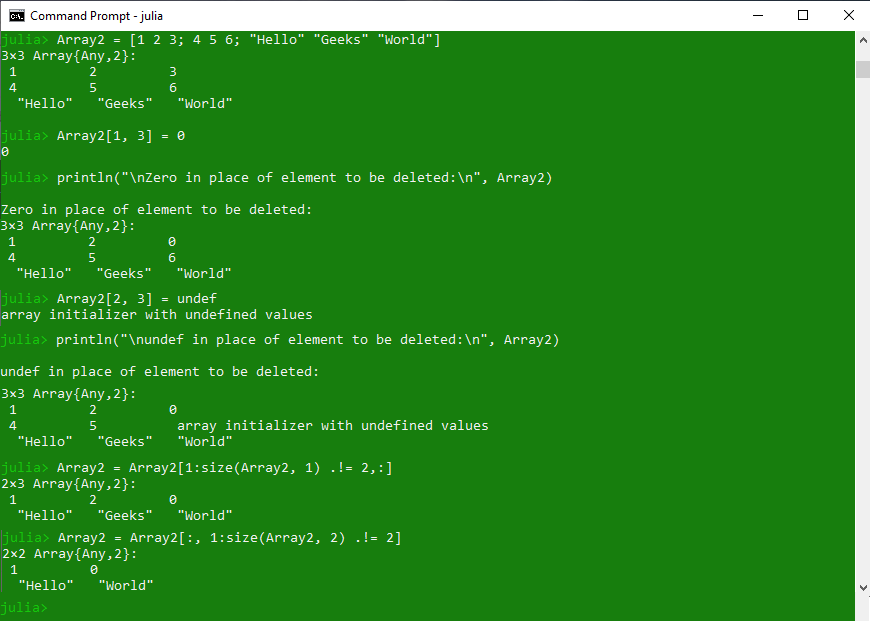
在上面的代码中,在删除整个行或列的同时,我们创建了另一个相同大小的数组,并将元素分配给新数组,但不包括要删除的行或列。这样做是因为在 Julia 中不允许从矩阵中删除行或列。示例:从 3D 数组中删除元素
蟒蛇3
# Julia program to illustrate
# the use of arrays
# Creating a 3D array
Array3 = cat([1 2 3; 3 4 5; 5 6 7],
["a" "b" "c"; "c" "d" "e"; "e" "f" "g"],
dims = 3)
println("Initial 3D Array:\n", Array3)
# Assigning zero in place of
# element to be deleted(e.g. element at 1, 3, 1)
Array3[1, 3, 1] = 0
println("\nZero in place of element to be deleted:\n", Array3)
# Assigning undefined value in place of
# element to be deleted(e.g. element at 1, 3, 2)
Array3[1, 3, 2] = undef
println("\nundef in place of element to be deleted:\n", Array3)
# Deleting entire row of elements(e.g. 2nd row)
Array3 = Array3[1:size(Array3, 2) .!= 2, :, :]
println("\nArray after deleting 2nd row:\n", Array2)
# Deleting entire column of elements(e.g. 2nd column)
Array3 = Array3[:, 1:size(Array3, 2) .!= 2, :]
println("\nArray after deleting 2nd column:\n", Array2)

数组方法
.数组表{
字体系列:arial、sans-serif;
边框折叠:折叠;
边框:1px 实心 #5fb962;
宽度:100%;
}
.array-table td, th {
背景颜色:#c6ebd9;
边框:1px 实心 #5fb962;
文本对齐:左;
填充:8px;
}
.array-table td:nth-child(odd) {
背景颜色:#c6ebd9;
}
.array-table th {
边框:1px 实心 #5fb962;
文本对齐:左;
}
.array-table td
{
边框:1px 实心 #5fb962;
颜色:黑色;
文本对齐:左!重要;
}
| Methods | Description |
|---|---|
| axes() | Returns the tuple or valid range of valid indices for specified array |
| broadcast() | Used to broadcast the function f over the specified arrays, tuples or collections. |
| broadcast!() | This function is same as broadcast() function but stores the result of broadcast(f, As…) in the specified dest array |
| cat() | Used to concatenate the given input arrays along the specified dimensions in the iterable dims. |
| colon() | Used to indicate and access every row and column |
| conj() | Used to compute the complex conjugate of a specified complex number z. |
| conj!() | Transforms the specified array to its complex conjugate in-place |
| copyto!() | Used to copy all elements from the specified collection src to array dest |
| count() | Counts the number of elements in the specified array |
| Dims() | Used to represent the dimensions of the specified AbstractArray |
| eachindex() | Creates an iterable object for visiting each index of the specified array |
| fill() | Returns an array of specified dimensions filled with a specific value passed to it as parameter |
| fill!() | Takes an existing array as argument and fills it with a new specified value |
| findall() | Returns a vector of indices or keys of the all true values from the specified array |
| findfirst() | Return the index or key of the first true value in the specified array |
| findlast() | Returns the index or key of the last true value in the specified array |
| findnext() | Returns the next coming index after or including i of a true element of the specified array |
| findprev() | Returns the previous index before or including i of a true element of the specified array |
| first() | Returns the first element of the specified array |
| getindex() | Returns the constructed array of the specified type and also the element of the array at a specific index. |
| hcat() | Used to concatenate the given arrays along second dimension |
| hvcat() | Used to concatenate the given arrays horizontally and vertically in one call |
| isassigned() | Tests whether the given index contains a value in the specified array or not |
| last() | Returns the last element of the specified array |
| length() | Returns the number of elements present in the specified array |
| ndims() | Returns the number of dimension of the specified array A |
| parent() | Returns the parent array of a specified array view type (i.e, SubArray) or the array itself if it is not a view |
| repeat() | Constructs an array by repeating the specified array elements with the specified number of times |
| reshape() | Returns an array with the same data as the specified array, but with different specified dimension sizes |
| reverse() | Returns a reversed copy of the vector. |
| reverse!() | Returns an in-place reversed copy of the vector. |
| reverseind() | Returns the corresponding index in v so that v[reverseind(v, i)] == reverse(v)[i]. |
| setindex() | Used to store values from the given array X within some subset of A as specified by inds. |
| similar() | Used to create an uninitialized mutable array with the given element type and size, based upon the given source array. |
| size() | Returns a tuple containing the dimensions of the specified array |
| stride() | Returns the distance in memory between the specified adjacent elements in specified dimension |
| strides() | Returns a tuple of the memory strides in each dimension |
| to_indices() | Used to convert the given tuple I to a tuple of indices for use in indexing into array A |
| vcat() | Used to concatenate the given arrays along first dimension |
| vec() | Reshapes the specified array as a one-dimensional column vector i.e, 1D array |
| vect() | Used to create a vector with the passed elements as parameter |
| view() | Used to return a view into the given parent array A with the given indices instead of making a copy. |
| @view() | Used to create a sub array from the given indexing expression. |
| @views() | Used to convert every given array-slicing operation in the given expression. |